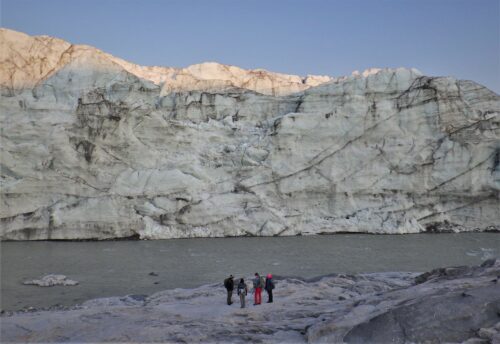Image courtesy of Sasha Leidman.
Who knew microscopic organisms could have huge impacts on climate change? “Bacteria” and “glacier melting,” two seemingly unrelated terms, were recently found to be deeply linked. Led by graduate student Sasha Leidman, a group of scientists from Rutgers University traveled to Greenland to collect sediment samples and drone images of glaciers. Previous research on supraglacial sediment existed, but it had never been quantified. There was little knowledge on how much cyanobacteria grew in the sediments or how they impacted the glaciers. “We didn’t even collect measurements of the bacteria at first, just because we had no indication that there was anything living in these sediments when we were first going out there,” Leidman said.
Then, these hydrologists made their discovery: the cyanobacteria in the sediments led to an increased glacier melting rate. The majority of this sediment was blown onto the ice sheet, then consolidated into what is known as cryoconite holes. When these cryoconite holes flood, all the sediment flows into streams and is deposited in floodplains. The cyanobacteria clump up on the sediment, which likely decreases albedo, the amount of light being reflected off the surface. Unable to reflect light off the surface, the glacier absorbs more heat from the sun and thus melts faster.
Studying these cyanobacteria may help scientists predict the level of glacier melting in the future. Correlating cyanobacteria growth with changing temperatures and hydrology will help Leidman and his team make glacier melting predictions as accurate as possible. For example, as these scientists examine how the bacteria in the sediment will change in the future, they can further evaluate the amount of flocculation—the clumping of bacteria—in supraglacial streams to produce more precise predictions of albedo. These scientists hope to use these climate models, incorporating the effects of cyanobacteria in the sediment, to predict how much melting there is tens to hundreds of years from now.
Due to COVID-19, the team was not allowed to travel to Greenland last summer, and this summer, it is still up in the air as to whether or not they can continue their research there. However, they are always ready. They are currently in the planning process and will head to Greenland as soon as possible. The team hopes to determine the biological constraints on cyanobacteria in streams and examine how these supraglacial streams affect atmospheric currents and weather patterns in Greenland and the polar regions.
Global warming is increasing temperatures, changing the sky’s cloudiness, and transforming ocean currents. “Greenland is melting at a scale that’s kind of hard to wrap your head around,” Leidman said. “Just during the past season, it lost 280 billion tons of ice.” Small changes in climate have a huge impact on Greenland’s surface mass balance and its contribution to the world’s rising sea level. These scientists are trying to use bacteria to quantify exactly how much glaciers are melting and to make that number as accurate as possible so that our society can plan for rising seas and climate change in the future.
Citations:
Leidman, S. Z., Rennermalm, Å. K., Muthyala, R., Guo, Q., & Overeem, I. (2021). The Presence and Widespread Distribution of Dark Sediment in Greenland Ice Sheet Supraglacial Streams Implies Substantial Impact of Microbial Communities on Sediment Deposition and Albedo. Geophysical Research Letters, 48(1), 2020GL088444.

